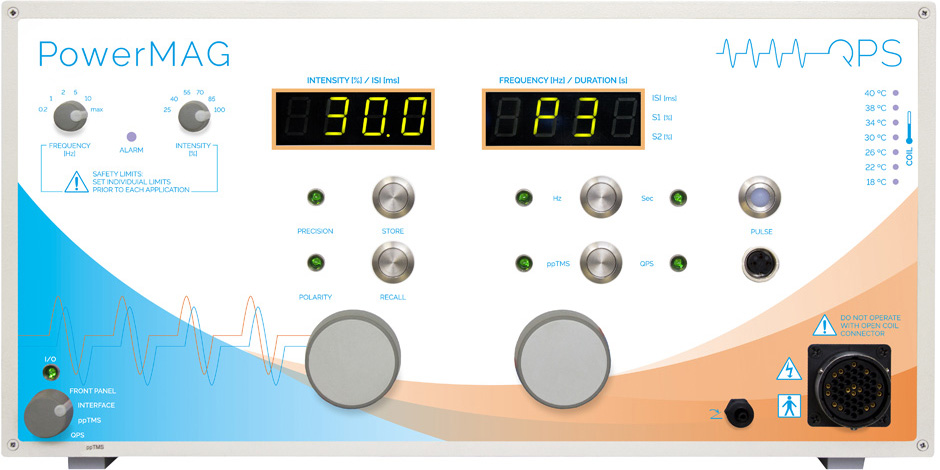PowerMAG QPS
Quattro-Puls Stimmulation – ein neue rTMS Pulsprotokoll für effektive Induktion von LPT/LTD
Die neue PowerMAG Technologie-Plattform ermöglicht
erstmalig die Kombination hochfrequenter QPS (Quattro-Pulse Stimulation), ppTMS (Paired-Pulse Stimulation) und online TMS-EEG in einem Gerät.
Der QPS kann ultra-schnelle biphasische Quadri-Pulse mit bis zu 666Hz, Theta Bursts und rTMS Pulse in einem Gerät abgeben.
Funktionen
- Ultra-Highspeed Bursts mit bis zu 666Hz
- bis zu vier Pulse in einem Burst-Paket
- gleiche Pulslänge in allen Stimulationsmodi und mit allen Spulen
- kein Intensitätsverlußt innerhalb der Bursts
- Biphasische-rTMS, Theta-Burst und QPS-Protokolle in einem Gerät
- Online EEG möglich
- Einphasige Standard-Stromversorgung ISI [ms] 1.5, 5, 50
- IBI [ms] 200, 1000, 5000
| Maximale Frequenz | 100 Hz |
| Minimale Frequenz | 0.1 Hz |
| Minimale ISI | 10 ms |
| ISI minimaler Änderungswert | 1 ms |
| Frequenz minimaler Änderungswert | 0.1 Hz |
| Maximale Frequenz bei 100% Intensität | 30 Hz |
| Maximale Intensität | 100 % (30 Hz), 80 % (50 Hz), 70% (100 Hz) |
Stimulationsparameter |
|
| Magnetische Induktion | bis zu 4 Tesla (spulenabhängig) |
| Maximale Pulskraft | 160 Joule |
| Pulsformen | Halb- und Vollsinuswelle |
| Spulenrichtung | Umkehrbar am Gerät |
| Spülzeit des Stimulationspulses | 80 μs (PA) |
| Pulsdauer | 160 μs |
Input/Output Interface |
|
| Auslöser Input | BNC-Steckverbindung (TTL Puls, active high) |
| Auslöser Output | BNC-Steckverbindung (TTL Puls, active high) |
| Externe Verbindung | 8-poliger DIN-Stecker (Einzelimpuls, rTMS, TBS, Rampe, benutzerdefinierte Stimulationsprotokolle möglich) |
| Synchronisation | BNC-Steckverbindung |
”Made in Germany“ Qualität |
|
| Number of discharges at 100% intensity | 2000000 |
| Anzahl der Entladungen bei 100% Intensität | Schutzklasse 1, Typ BF |
| Hardware-Klassifizierung nach MDD 93/42/EEC | Klasse IIa |
| Hardware-Zertifizierung | EG Einzelgeräteprüfung |
Operating Parameters |
|
| Stromversorgungsspannung | 220/230 V~, 50 Hz, 120 V~, 60 Hz mit PowerUNIT |
| Stromverbrauch | 50 VA im Stand-by-Modus, 800 VA Nennwert, 2000 VA |
| Arbeitstemperatur | 0 ⁰C bis +30 ⁰C |
| Abmessung | 490 x 260 x 600 mm |
| Gewicht | 38 kg |
Wählbare QPS-Protokolle:
| P1 | P2 | P3 | P4 | P5 | P6 | P7 | P8 | P9 | Hamada | |
| ISI [ms] | 1.5 | 1.5 | 1.5 | 50 | 50 | 50 | 5 | 5 | 5 | 1.5 |
| ITI [ms] | 200 | 1000 | 5000 | 200 | 1000 | 5000 | 200 | 1000 | 5000 | 5000 |
| ITI [s] | 0.2 | 1 | 5 | 0.2 | 1 | 5 | 0.2 | 1 | 5 | 5 |
| Frequenz [s] | 5 | 1 | 0.2 | 5 | 1 | 0.2 | 5 | 1 | 0.2 | 0.2 |
| Anzahl von Trains | 360 | 360 | 360 | 360 | 360 | 360 | 360 | 360 | 360 | 360 |
| Anzahl von Pulses | 1440 | 1440 | 1440 | 1440 | 1440 | 1440 | 1440 | 1440 | 1440 | 1440 |
| Gesamtdauer [s] | 72 | 360 | 1800 | 72 | 360 | 1800 | 72 | 360 | 1800 | 1800 |
| Gesamtdauer [min] | 1,2 | 6 | 30 | 1,2 | 6 | 30 | 1,2 | 6 | 30 | 30 |




